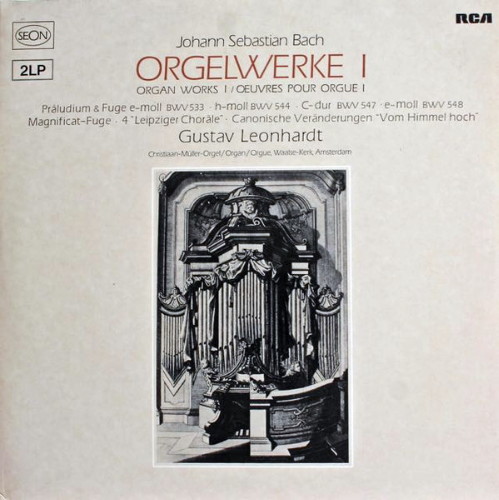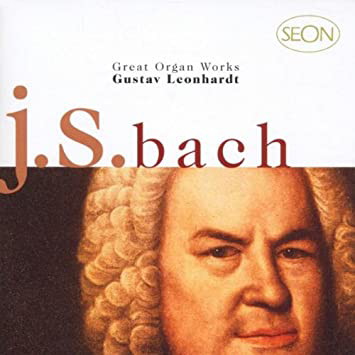 |
2 LPs
- 6775 001 - (p) 1973
|
 |
| 2 LPs -
RL 30382 - (p) 1980 |
 |
| 2 CDs -
SB2K 63185 - (c) 1997 |
|
ORGELWERKE I
|
|
|
|
|
|
|
|
| Johann Sebastian
BACH (1985-1750) |
Prelude
and Fugue in C Major, BWV 547 |
|
10' 27" |
A1 |
|
Prelude
and Fugue in B Minor, BWV 544 |
*
|
13' 45" |
A2
|
|
Fuga sopra il Magnificat,
BWV 733
|
|
4' 27" |
B1
|
|
Canonic
Variations on "Von Himmel hoch, da komm'
ich her", BWV 769
|
|
15' 10" |
B2 |
|
Prelude
and Fugue in E Minor, BWV 533 |
*
|
5' 37" |
C1 |
|
Prelude
and Fugue in E Minor, BWV 548 |
|
16' 29" |
C2 |
|
From
the "18 Leipzig Chorales": |
|
|
|
|
-
O Lamm Gottes unschuldig, BWV 656 |
*
|
9' 07" |
D1 |
|
-
Nun komm' der Heiden Heiland, BWV
659 |
*
|
5' 08" |
D2 |
|
-
Von Gott will ich nicht lassen, BWV
658
|
*
|
5' 34" |
D3 |
|
-
Vor deinen Thron tret' ich hiermit,
BWV 668 (Cantus firmus im Sopran (Bricht
im 26, Takt ab)
|
*
|
5' 42" |
D4 |
|
|
|
|
|
| Gustav
Leonhardt, at the Christiaan Müller
Organ of the "Waalse Kerk" Amsterdam,
built 1733/34 |
|
|
|
|
|
Luogo
e data di registrazione |
|
Gennaio 1972
|
|
|
Registrazione: live
/ studio |
|
studio |
|
|
Producer /
Recording Supervisor |
|
Wolf Erichson
|
|
|
Recording Engineer
|
|
Dieter Thomsen
|
|
|
Prima Edizione LP |
|
Seon (Philips) | 6775
001 | 2 LPs - durata 43' 49" - 47'
37" | (p) 1973 | ANA
Seon (RCA Red Seal) | RL 30382 | 2
LPs - durata 43' 49" - 47' 37" |
(p) 1980 | ANA
|
|
|
Edizione CD |
|
Sony | SB2K 63185 | 2
CDs - durata 70' 11" - 77' 34" |
(c) 1997 | ADD
|
|
|
Original Cover
|
|
Jacob Schübler -
Große Kirchenorgel, nach I. N.
Steidlin
|
|
|
Note |
|
I brani
contrassegnati con (*) asterisco
non sono stati riversati in questo
doppio CD il quale contiene anche
brani di altra pubblicazione (Seon
6775 018).
|
|
|
|
|
Johann
Sebastian Bach's fame as a
composer and virtuoso
instrumentalist was
primarily founded on his
organ playing. In his
obituary he was described as
“the greatest organist and
keyboard player that ever
lived.” Certainly in the
18th century he had no equal
as an organist. His playing
was consummate in every
respect: his mastery of the
art of extemporization, his
use of the pedal - which
quite astonished his
contemporaries, and his
skilful registration. As an
inspector of organs, too,
Bach was highly esteemed -
and also feared. “His
examinations were very
strict, but always fair,”
wrote Forkel, the first Bach
biographer (1802), who was
in the fortunate position of
having the direct reports
and judgements of Bach's own
sons and pupils. Carried out
in the district of
Thuringia-Saxony, it was in
fact these organ
inspections, involving an
obligatory “test” concert,
that showed most vividly
“again and again, that Bach
was truly the prince of
organists and keyboard
players” (Forkel). Bach owed
his utter familiarity with
the organ to the fact that
his daily routine had nearly
always revolved around this
“king of instruments”. Even
during the period he spent
as court capellmeister at
Cöthen (1717-23), when he
had regularly to produce
chamber music and orchestral
works, he never neglected
the organ. Important
compositions from this
inspired period, such as the
Fantasia and Fugue in G
minor, the “Dorian” Toccata
and Fugue or the Passacaglia
in C minor, provide eloquent
proof of this. Thus his
organ works, be they free
compositions or allied to
chorales, spread themselves
pretty evenly over the
50-odd years of Bach's
creative life. In them we
can follow the various
stages of development, from
the musical models of his
youth, via the “Sturm und
Drang” period of the Weimar
years, when he struggled to
find his own individual
idiom, to the various phases
of artistic maturity.
In the field of free organ
compositions Bach revised
the prelude/fantasia and
fugue combination, modelling
it more on the recitative
and aria form. Instead of
the loose, extemporized
nature of his predecessors'
works, Bach aimed at a more
homogeneous shape for the
individual movements. The
prelude was to serve as a
preparation; the fugue was
the real nucleus of the
work. The emotional content
of the fugue sprang
essentially from the
pregnant depths of its main
subject. Written in 1709 in
Weimar, or perhaps even
earlier, the Prelude and
Fugue in E minor, BWV 533,
shows the young composer
seeking new paths. We find
that the Prelude is
thematically closely related
to the Fugue, but that
Buxtehude's fanciful organ
style - “shaken” chords,
toccata-like passages and
pedal leaps - still echoes
through. The immediate
impact that this music has,
the exciting progress of
events coupled with
virtuosity, gives glimpses
of the mature artist even at
this early stage, and in
spite of occasional
imperfections in the form.
But what superb mastery is
displayed in the companion
work in E minor (BWV 548)!
Composed during the late
Leipzig period, the work is
monumental, both in respect
of its external proportions
and its inner stature. Bound
by pretty harsh restrictions
during the Prelude - uniform
thematic material and a
pedal point - the music is
then released into one of
the boldest and freest
fugues Bach ever wrote. The
Fugue is constructed in
three sections, with an
initial fugal section, a
toccata-like middle section,
and then a complete
recapitulation of the first
section, and represents a
wholely successful attempt
to combine three essentially
heterogeneous elements: the
fugue, the toccata, and the
concerto.
The other two free organ
compositions on this
recording also date from the
late Leipzig period. Bach
always associated the key of
B minor (BWV 544) with the
sanctified sphere of
suffering and death. The
poignant lyricism of the
Prelude is reminiscent of
the melismatic “Erbarme
dich" ("Have mercy") aria
from the Matthew Passion,
whereas the chromatic
sequences could have been
taken from the first Kyrie
section of the B minor Mass.
As far as content is
concerned the Prelude and
the Fugue form an entity.
The Fugue, again constructed
on a grand scale and divided
into three sections,
develops out of an
unpretentious theme, which,
in the middle section, is
joined by a further theme,
derived from the second
obbligato counterpoint. Bach
himself obviously cherished
this particular work, for he
wrote out the original
manuscript with the utmost
care - it is one of the most
beautiful he ever wrote.
The Prelude and Fugue in C
major (BWV 547) is on quite
a different emotional plane,
one of joyful, festive
expectancy. In the opening
movement we hear the
familiar carillon motive
from the organ chorale "In
dir ist Freude" ("In Thee is
joy") resounding in the
pedal; there are also
obvious thematic connections
with the lively opening
chorus of Cantata No. 65
"Sie werdrn aus Saba alle
kommen" ("All they from
Sheba shall come"). The work
is written in a highly
concentrated manner, with
closcly woven counterpoint -
a typical feature of Bach's
late syle. The fugue subject
appears no fewer than 50
times in its original form,
in inversion, stretto and
augmented! Bach delays
bringing in the pedal until
the fifth entry, at which
point the fugue subject
appears simultaneously in
the bass - in augmented
time-values - and piled up
above it in the upper
voices, thus creating a
tremendous clash of
dissonances, which only
gradually resolves itself.
This work in particular is a
striking example of Bach's
endeavours to exalt the
prelude and fugue as a form,
both from a spiritual and
from a technical point of
view.
Hardly less important than
the free organ compositions
are the organ compositions
allied to particular
chorales. Closely connected
with the text of the chorale
tune on which it is based,
this type of organ
composition became, in the
hands of Bach, an esoteric
work of art. Basically the
work serves to interpret the
chosen text, and to this end
Bach employs the language of
musical symbolism, “leading
motives” and symbolic
musical constructions, as
well as musical devices that
depict specific emotions.
Bach based his “Fuga sopra
il Magnificat” (BWV 733),
written in Weimar, on St.
Luke's Gospel chapter 1,
46-47 (“My soul doth magnify
the Lord”), creating a
freely fugal piece full of
invention and stimulating
rhythms. In the “Canonic
Variations on “Vom Himmel
hoch” (BWV 769; 1746/47),
written close to the end of
his life, a popular German
Christmas carol attains
great heights of
spiritualization in a series
of increasingly
sophisticated variations. In
Bach's autograph copy we
find two variations set
before and two after a
contrapuntally intricate
centrepiece in which the
cantus firmus itself is
presented canonically in
four different ways. Music
tending to such abstraction
does not immediately reveal
its profundity and
uniqueness to the listener.
The four chorale preludes
recorded here are taken from
an autograph collection of
“Eighteen Chorales” dating
from the last year of Bach's
life, in which the composer,
looking back with the wisdom
of old age, attempts to
summarize his work,
examining, ordering,
reviewing the fruits of his
labours. Some of the pieces
go back as fast as the early
Weimar years. “O Lamm
Gottes” (BWV 656) grows from
dreamy beginnings into a
powerful proclamation of
faith; the old advent hymn
“Nun komm' der Heiden
Heiland” (BWV 659) is woven
into a thick web of
imitative work; “Von Gott
Will ich” (BWV 658) has the
cantus firmus in the pedal.
Bach was physically too weak
to finish writing the
manuscript. Overtaken by
blindness he dictated to his
son-in-law Altnikol his last
great profession of faith:
“Vor deinen Thron tret' ich”
(“I step before Thy
throne”), BWV 668, a chorale
dating from the Weimar
period, which flows along
melodiously in peaceful
tranquility. In the 26th bar
he had to break off- his
legacy was complete. We owe
the finished version of this
chorale prelude to Bach's
son C. P. E. Bach.
Lothar
Hoffmann-Erbrecht
English
translation by Avril Watts
|
  |
|
|